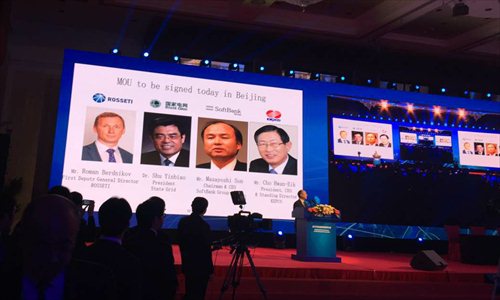HOME >> BUSINESS
State Grid joins drive for NE Asia transmission network
By Chu Daye Source:Global Times Published: 2016-3-30 21:08:02
SoftBank chief ‘can lose for a few years’ in pursuit of big vision

The 2016 International Conference on Global Energy Interconnection is held in Beijing on Wednesday. Photo: Chu Daye/GT
State-owned power transmission company State Grid Corp of China (SGCC) signed a joint memorandum of understanding (MOU) on Wednesday in Beijing with three heavyweight companies from Russia, South Korea and Japan.
The four will establish a framework to cooperate on research and planning to promote an interconnected electric power grid spanning Northeast Asia.
The other three companies are South Korean public power leader Korea Electric Power Corp, electric company and operator of Russia's energy grid PJSC ROSSETI and SoftBank Group Corp of Japan.
The signing ceremony was held at the 2016 International Conference on Global Energy Interconnection held in Beijing on the same day.
Liu Zhenya, chairman of SGCC, said during a speech Wednesday that global energy development faces main challenges: resource constraints, environmental pollution and climate change.
Liu said smart grids, ultra-high-voltage (UHV) grids and clean energy will provide the only path to a green, low-carbon, economical, efficient and open energy system with sustainable supply.
China is accelerating construction of UHV power transmission lines across the country and exporting its proprietary technology in this sector.
UHV, which is defined as voltage of at least 1,000 kilovolts for alternating current or 800 kilovolts for direct current, is designed to transmit large amounts of power over long distances with less loss of electricity than the commonly used 500-kilovolt power transmission lines.
SGCC won two contracts for UHV lines to carry hydropower from the Belo Monte Dam, one of Brazil's largest hydroelectric projects, in 2014 and 2015. The deals were hailed as a milestone in China's export of electricity transmission technology.
Masayoshi Son, chairman & CEO of SoftBank, said Japan, a developed economy, can learn in the energy sector from China, a developing economy.
"China is already the biggest country in the world for wind, solar power generation and also UHV grids. And [China] has scale, so we can learn many things from China's success. Also, by interconnecting, we can help each other on supply and demand," the billionaire said.
Son and SoftBank are investing in wind and solar power to replace nuclear power in the wake of the 2011 Fukushima disaster in Japan, media reports said.
As there will be occasional demand/supply gaps in one country, an interconnected grid could help, he said.
The sun always shines somewhere on Earth, and the wind always blows somewhere on Earth, the SoftBank chairman said during his speech at the conference.
However, creating a massive cross-border grid will require intense intergovernmental cooperation, experts said.
Based on the MOU, the four companies will start feasibility studies on multinational power grid interconnections in the Northeast Asia region and jointly conduct business evaluations. The companies will then seek support from their governments and establish business structures to realize the proposed plan.
"I don't want to lose money," Son laughed, when asked how much he is prepared to lose on the plan.
"If we have to lose for the big vision, sometimes I don't care to lose for a few years, but in the long run, we hope to make the money back," he told the Global Times Wednesday.
The billionaire said he is confident that the four firms, including his company, will be able to pull off the project.
The legendary investor, who has funded hundreds of tech start-ups over the past two decades including Alibaba Group Holding, said he has spoken with the Japanese government. It said that after the companies study such issues as cost, technology and environmental impact and "if it all makes sense on the business aspect, then the government will try to help."
Posted in: Companies